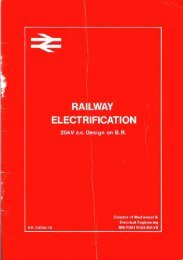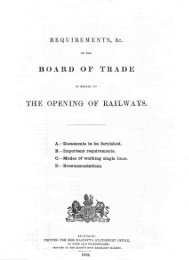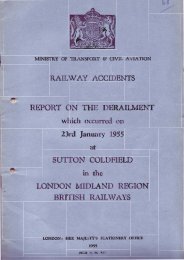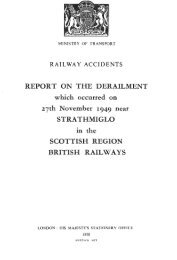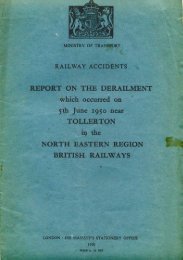R A I LT R AC K - The Railways Archive
R A I LT R AC K - The Railways Archive
R A I LT R AC K - The Railways Archive
You also want an ePaper? Increase the reach of your titles
YUMPU automatically turns print PDFs into web optimized ePapers that Google loves.
sustaining<br />
We are determined to<br />
seize this opportunity<br />
to improve the quality<br />
of life for travellers<br />
and non-travellers in<br />
the UK<br />
44<br />
4.8<br />
4.8 Environment<br />
Environmental vision<br />
This NMS is the first in a new era for the railways.It is an<br />
opportunity for us to explain how we will take forward the<br />
exciting new challenges of the White Paper A New Deal for<br />
Transport:Better for Everyon e which describes ‘the potential<br />
for a railway renaissance’.<strong>The</strong> NMS maps out investments<br />
which will be crucial to delivery of sustainable mobility in<br />
GB.We are determined to seize this opportunity to improve<br />
the quality of life for tr avellers,and non-travellers,in the UK.<br />
Achieving a sustainable transport network presents a<br />
serious challenge. In 1998,the Royal Commission on<br />
Environmental Pollution reported that,in the 1980s alone, an<br />
area of 10,500 hectares,equivalent to the size of Bristol,was<br />
taken for road-building and parking.Furthermore, the<br />
Government has published figures which show that up to<br />
24,000 vulnerable people are estimated to die prematurely<br />
each year because of exposure to air pollution, much of<br />
which is due to road traffic.This is in addition to the 120<br />
deaths and injuries which occurred every day in accidents on<br />
UK roads in 1997.<strong>The</strong>se figures are unsustainable. In<br />
contrast,the railways offer efficient transport at much lower<br />
environmental and social cost.<br />
For example, freight tonne-kilometres have increased by<br />
30% in the past two ye a rs and passenger kilometres on ra i l<br />
h ave increased by 15% over the same peri o d . Had these<br />
increases been on the road netwo rk , this growth would have<br />
resulted in the emission of an extra 1.5M tonnes of carbon<br />
d i ox i d e. If other impacts, including reductions in air pollution,<br />
a c c i d e n t s , congestion and noise are calculated using standard<br />
unit values, the benefit delivered by the ra i lw ays relative to<br />
the roads, for this passenger and freight growth alone, w a s<br />
a p p r ox i m a t e ly £470M. F u rt h e rm o r e, we have estimated that,<br />
by 2011, g r owth of passenger and freight tra f fic could be<br />
wo rth £4.6bn annu a l ly in social and environmental benefi t s .<br />
Given that demand for transport in the UK is growing<br />
rapidly, and that the UK’s fastest-growing contributor to<br />
climate change is through carbon dioxide emissions,the<br />
savings achievable through a modal shift from road to rail will<br />
be key to the Government achieving its objectives for<br />
environmental protection.<strong>The</strong> Government has described<br />
traffic growth as ‘the greatest global threat facing the<br />
international community’.<strong>The</strong> rail network can provide a<br />
major part of the solution to these environmental problems.<br />
At the Rail Summit on 25 February 1999, John Prescott said,<br />
‘I believe most of the industry shares my vision for a modern<br />
railway . . . playing its part in an integrated transport system<br />
and contributing to a sustainable society’.<br />
<strong>The</strong> opportunity for the rail industry is tremendous.For<br />
example, while more than 80% of domestic freight currently<br />
travels by road, we now have support from a government<br />
which wants to see a real increase in freight movement by<br />
rail.Our investment plans have been geared to deliver<br />
environmental benefits.<strong>The</strong> Deputy Prime Minister has been<br />
actively looking for companies prepared to join the<br />
Government in shaping ‘a new future for sustainable<br />
transport’. We have taken up that challenge.<br />
<strong>The</strong> Government has backed these demands with firm<br />
financial commitments.It will boost the take-up of freight<br />
grants,and put more money into support for new<br />
investment proposals that produce wider benefits for both<br />
integration of the transport network and shifting traffic from<br />
road to rail.<strong>The</strong> Shadow Strategic Rail Authority will also be<br />
a key player. It is likely to have a responsibility to oversee<br />
rail’s contribution to sustainable development objectives.<br />
We are fostering a more productive relationship with<br />
the Environment Agency, by seeking the Agency’s advice to<br />
help us prevent adverse environmental impacts.Last year, we<br />
signed the first-ever memorandum of understanding with the<br />
Environment Agency, putting our relationship on a clear and<br />
open footing.<br />
We now look forward to constru c t i ve regulatory support<br />
at the highest leve l .In return , we can offer commitments and<br />
action in six areas which are outlined below.



